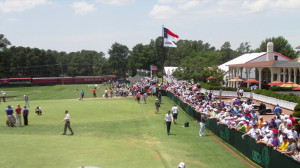
PINEHURST, N.C. – As a past champion in 2003 and with runner-up finishes in 2006 and 2007, Jim Furyk has to be considered a contender to win the 2014 U.S. Open that begins play on Course No. 2 at Pinehurst Resort and Country Club on Thursday.
Maybe since he’s missed the cut in two of the last three U.S Opens he’s played in, finishing tied for fourth in 2012, Furyk wasn’t called to the podium over the past three days to answer questions in front of the media en masse.
Instead, he was able to go about his business preparing to play in his 20th consecutive USGA championship as well as to take some time to talk about his game on a more intimate level after finishing his practice round on Wednesday.
“I feel alright,” Furyk said.
“I had a really good April and beginning to May. My last two events at the end of May, I made the cut. I finished 50th at Colonial and I think I finished T-19th at Memorial – it was a solid event.”
With that mindset and with one of the most consistent and productive swings on the PGA Tour, it wasn’t surprising that he almost dunked his tee shot on the par-3 17th hole during his practice round.
Furyk appreciated the test No. 2 presented after being restored close to its original form by Bill Coore and Ben Crenshaw, who wanted today’s golfers to experience what the course’s original creator, Donald Ross, wanted for those who played it back in 1907.
“It’s a different golf course,” Furyk said.
“The tee shots are different. I think everyone’s trying to figure out how aggressive, how conservative to play off the tee. The green complexes are what we saw in ’99 and in ’05 for the most part. The peripheries around the greens are a little different. They’re greener on those runoffs. So the greens are gonna’ be brown and the fairways are getting’ browner, but those little areas hold moisture. They’re green, so it’s hard to roll a ball through there because of the grain.”
Similar to a point made a day earlier by Ian Poulter, Furyk agreed that a strong short game will be the key to getting the ball onto the undulating and crowned greens and close enough to birdie the hole or save for par, depending how aggressive the strategy is.
With an overall length of 7,562 yards, and with many waste areas and bunker complexes peppered with plentiful amounts of wire grass and native plants, you’d think that Furyk would consider the par 3’s as the spots to target for birdies, particularly since he almost aced one earlier on.
“I don’ think it puts any more emphasis on three’s, they’re already tough” he said.
“They added distance to six, they added distance to 17 for sure, and I’m not sure if they added it to 15 or not. They’re tougher, they’re tougher. They’re difficult green complexes as it is to get the ball on the surface of those par 3’s.”
As playing close to par is a reasonable predicted score to post to contend for a U.S. Open title, Furyk has produced the stats this season to be in the mix, having played 30 rounds out of 44 under par (21) or to par (9).
“I’d like to get back to the form I had through April and May when I had a nice tear there for about six weeks where I had some high finishes – I had two second places.
“I feel good about my game. I’ve got a lot of confidence from the past couple of months.”
